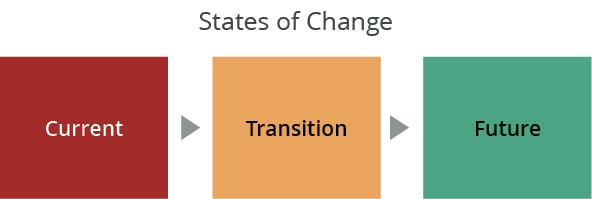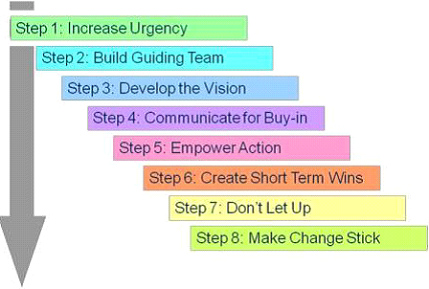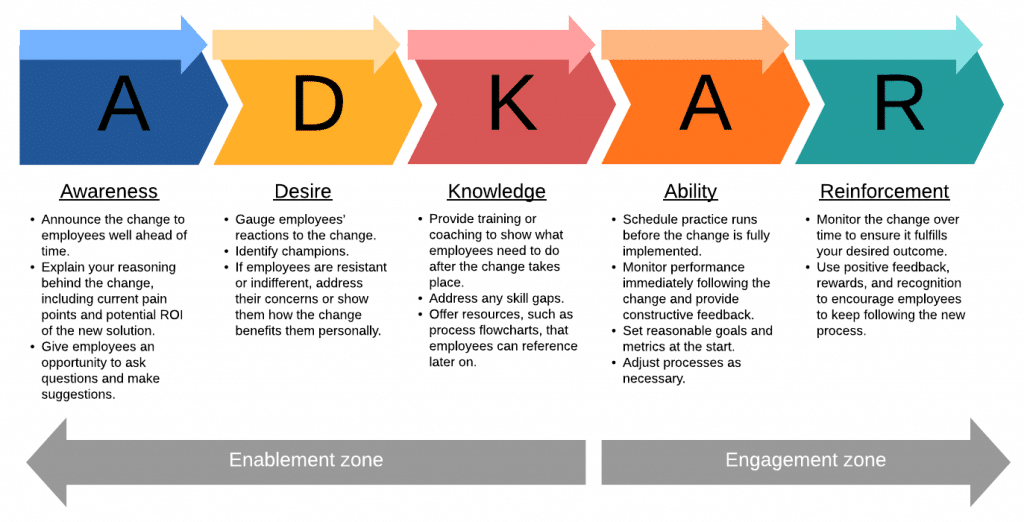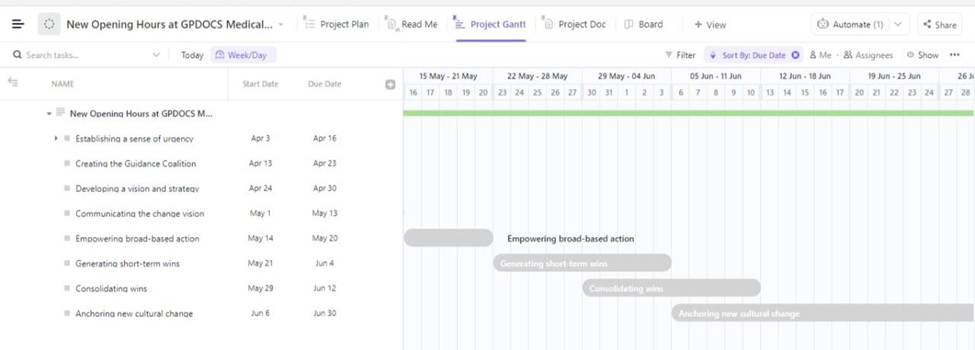All corporations must evolve and alter to compete effectively and meet the ever-increasing requirements of their clientele. Strategic change management is the procedure of managing transformation deliberately and systematically to accomplish a company’s objectives, ambitions, and priorities (Rosenbaum et al., 2018). Typically, the need for adjustment is prompted by external causes like new regulations or stiff rivalry or by internal variables such as the development of innovations. Nevertheless, change execution is a complicated task that is not always accomplished, owing primarily to ineffective communication or underestimating the quantity of retraining needed (Rosenbaum et al., 2018). While new work procedures and processes can be implemented reasonably quickly, workplace culture may also require alteration to accommodate the new operating methods, which may take significantly longer than anticipated.
When it comes to handling the effects of transformation on the enterprise, various factors come into play, including the components that will take much longer to address and the modifications that will be more imperative to integrate for transition to be implemented appropriately. According to Wiedner et al. (2017), distinct adjustment forms influence the course that change may follow and how they might be integrated to support a phased approach to change implementation. The four distinct types of change enumerated by Wiedner et al. (2017), evolution, revolution, adaptation, and reconstruction, will emphasize either the end outcome or the nature of the alteration. Institutional evolution is a natural process in which the corporation and its members achieve a higher state of awareness.
It is a component of progression that entails the development of the capacity for systematic thought, trustworthiness, and transparency. Wiedner et al. (2017) insinuated that evolutionary transformation is gradual and occurs over time. Businesses visualize revolutionary transformation, including a complete revamp, restoration, and reconfiguration, as change is profound, sensational, and frequently permanent. From a firm’s standpoint, revolutionary transition realigns and reshapes tactical objectives, often resulting in massive changes in beliefs and thoughts (Wiedner et al., 2017). Adaptation change is the gradual modification of behavior in reaction to external activities (Wiedner et al., 2017). External circumstances such as rival behavior and digital innovations necessitate a response from a business, but none that entails significant transformation across the firm. Adaptation will come to encompass more than responding to destabilizing factors; it will also include identifying and embracing possibilities provided by the marketplace or the company’s performance. Reconstruction is a process of realigning how the organization runs through implementing numerous initiatives concurrently (Wiedner et al., 2017). It entails quick transformation that does not completely alter the culture.
States and Processes
When companies transform, they migrate from what they have experienced and accomplished to a preferred contemporary look of acting and performing their job. Considering change as a procedure is critical for effective transformation and project management. The simplest and most fundamental method of comprehending change as a procedure is to break it down into discrete, understandable components. The three states of change, the present situation, the transition state, and the future state, provide an appropriate structure (Lungeanu and Zajac, 2019). The figure below illustrates the conditions of change that may help an organization execute transformations.

The current state is how activities are carried out in the present day, and it is comprised of a series of tasks, attitudes, instruments, innovations, institutional arrangements, and job positions. The transition state is unorganized and chaotic because it is uncertain and continually changing. This phase is frequently emotionally charged, eliciting a spectrum of feelings from fear and desperation to rage and pleasure. The transitional state necessitates firms to embrace new ideas and develop new behaviors while continuing to make daily efforts. The future state is the destination that organizations are attempting to reach and is sometimes imprecisely characterized and subject to change as businesses trudge through the transition period.
The future phase may not align with the corporation’s professional and personal objectives, and there is a possibility that they will fail in this state. On the other side, the process perspective is concerned with how the change is accomplished; the change’s mechanism (Lungeanu and Zajac, 2019). It will examine the sequence of steps, the pace with which they are completed, and the stream of information and stakeholder feedback. The intention of these two viewpoints for the corporation implementing the alteration is to have a clear picture of how the change is handled (Lungeanu and Zajac, 2019). Therefore, this will allow those responsible for the transformation to recognize, evaluate, and portray the initiatives’ performance and then decide on the best course of action.
The Change Process
Four ideas characterize different phases in a foundation’s change management plan. These are the teleological, life cycle, evolutionary, and dialectical theories (Jabri, 2017). These four ideas are motivated by various organizational contexts and the degree of change necessary. According to the life cycle hypothesis, an institution progresses through a series of comprehensive steps, preserves traits established in earlier phases, and is conjunctive in nature. According to this view, transformation occurs in stages, each stage adds to the end paradigm of transition, and they should be performed in order, as each step contributes to the next (Jabri, 2017). The teleological concept is predicated on the premise that the primary motivation for any entity’s activity is its destination.
As per this notion, any organization’s growth and transformation are guided toward a specific objective or desired state. It is predicated on the assumption that a corporation communicates with others, articulates the desired outcome, implements essential activities, and assesses progress. The dialectical logic insinuates that companies exist in a heterogeneous universe of intersecting circumstances, impulses, and opposing ideals vying for dominance and control (Jabri, 2017). These elements can be internal or external to the organization. The proponents of this viewpoint suggest that an opposing occurrence precedes every phenomenon. The evolutionary hypothesis of change enumerates that all societies began as simple and gradually got more sophisticated (Jabri, 2017). According to evolutionary science, transformation is a good and useful factor in society. Thus, as circumstances change, society becomes stronger and more adaptable.
Key Activities in the Change Process
Change processes begin with a set of preconditions and end with a functional status; the procedure in between is continuous and evolves in cycles. According to Hayes (2022), the transformational approach consists of seven critical actions covered in this study. The first step involves identifying and accepting the need for change and persuading stakeholders to adapt and cooperate with the alteration. Thus, this will include forming a team that guides and directs the transition process. The second stage is diagnostic, during which the institution’s present state is evaluated (Hayes, 2022). Once the existing condition is comprehended, it becomes easier to envision the anticipated change state, which facilitates identifying potential change impediments.
Additionally, by doing so, it will be feasible to clarify what demands to change and identify an acceptable future condition for stakeholders. Third, planning is critical for establishing and conveying how the change mechanism will be handled, including emphasizing and assessing potential impediments to implementing the transformation (Hayes, 2022). Throughout the planning phase, sufficient attention must be given to technical glitches and personnel issues. Fourthly, adopting and assessing the progress level entails carrying out the plan developed during the design step (Hayes, 2022). It is critical that during the project execution, attention is paid to articulating the reason for the change to increase stakeholder buy-in.
Throughout the execution phase, it is critical to assess achievements to evaluate whether the recommended plan is appropriate and achieves the desired result or whether it should be examined, rebuilt, and advanced further. Fifth, the supporting the change action phase evaluates how stakeholders have embraced the transition once the targeted future situation has been reached to guarantee it becomes the expected trend (Hayes, 2022). Sixth, controlling and directing individual issues as an activity considers the technical specifications of change implementation and the workforce management aspect. Finally, change administrators would undertake learning activities to evaluate their behavior, the processes they have implemented, and the lessons they may have learned (Hayes, 2022). Thus, this is critical since it will increase the likelihood that transformation leadership will accomplish the maximum suited change process.
Change Management Models
To aid GPDOCS in executing change, various transformational management paradigms have been developed and are regarded as providing a structure for managing and executing change. Three of the most widely used change management approaches are discussed in greater depth below.
Kurt Lewin’s Change Management Model
Kurt Lewin devised a three-step transformation paradigm that included unfreezing, modifying, and refreezing. The model is a straightforward approach to comprehending the transformation process. According to Lewin, the implementation of evolution comprises first developing the idea that a transition is necessary, then progressing toward the expected new extreme of conduct, and ultimately, consolidating the change in behavior as the standard (Hussain et al., 2018). Due to the natural resistance of many individuals to change, the purpose of the unfreezing stage is to promote consciousness of how the status quo, or present level of appropriateness, is impeding the corporation somehow. Communication is critical throughout the unfreezing process to guarantee that workers are informed of the impending change, its rationale, and how it will impact them.
Second, the implementation of the change, also known as transitioning or shifting, denotes the changing procedure. People acquire new habits, thoughts, and philosophies throughout the shifting stage. The more adequately equipped they are for this process, the smoother it will go. As a result, personnel’s instruction, engagement, assistance, and time are crucial to adjust to the change. Finally, the refreezing step represents strengthening, solidifying, and consolidating the newly formed condition following the alteration (Hussain et al., 2018). Changes to organizational procedures, objectives, architecture, products, or personnel are acknowledged and refrozen as the new baseline or established order.
The merits of Lewin’s three-step model include:
- Its simplicity and that it requires buy-in from participants to accomplish the desired change. Thus, the concept has been in use for a long time.
Disadvantages of Lewin’s model are as follows:
- Nevertheless, the model’s shortcomings include the variety of theoretical assumptions about the institution’s character. The assumptions include the company intending to make improvements is stable, the preference for minor iterative development, and the disregard for the influence of policy and authority inside the firm on the execution of recommended changes.
Kotter’s Change Management Model
Kotter established the Eight-Step Model of Transition, which he designed after studying firms undergoing change. The eight steps in the transformation process are as follows: constructing a sense of urgency, creating strong governing coalitions, establishing a strategy and vision, articulating the vision, eliminating impediments, and inspiring workers to act (Tang, 2019). Additionally, Kotter’s models include the following steps: achieving short-term successes and consolidating gains and reinforcing change by grounding it in the culture (Tang, 2019). The graphic below illustrates Kotter’s eight-step paradigm.

The benefit of Kotter’s eight-step paradigm is that:
- Each stage is clearly stated, making it simple to follow.
- Establishing a clear call to action in step one engages stakeholders and allows them to feel as though they are an integral part of the solution brought about by the adjustment.
The downsides of Kotter’s eight-step model include:
- That the process becomes very top-down, dominated by emphasizing the critical role of strong leadership in enacting change (Tang, 2019). As a result, this can occasionally create tension among personnel, who may perceive that the transition is being imposed on them rather than consulting them and involving them in the process, thereby making the transformation a collective endeavor.
Hiatt’s ADKAR Change Management Model
The ADKAR change management framework is a five-step process that guides stakeholders through successive steps required for effective change implementation. According to Balluck et al. (2020), the ADKAR model depicted above provides a structure and procedure for handling the human side of change. As with the previous transition management paradigm examined thus far, all strategy phases must be followed precisely and in sequence to achieve success. The sequence cannot be altered, and no stage can be omitted. Thus, this would constitute sabotage of the necessary transformation.

The benefits of the ADKAR model include:
- When all stages are implemented, stakeholders will experience invigorated, empowered, and prepared to respond to the reform. Therefore, it is partial because ADKAR takes a bottom-up rather than a top-down perspective.
The downsides of the ADKAR paradigm are:
- That its bottom-up approach does not necessarily lend itself to large-scale transformation.
- Additionally, the model presupposes the existence of change management methods for executing the change.
Kotter’s Eight Step Model for GPDOCS
Transformation is challenging, and in the context of GPDOCS, it can disrupt the established order and create conflict. At GPDOCS, nevertheless, change is required, and Mr. Dee may use Kotter’s Eight-Step Change Management framework to accomplish this. It explains how to execute transition in a company in a coherent and thorough manner. Developing a feeling of urgency among management and staff should be the first step. As the necessity for adjustment is vital for corporation development, Mr. Dee should engage all stakeholders. Bringing together a leading alliance is all about assembling a talented squad with the appropriate skills, credentials, credibility, relationships, and enough authority to spearhead change activities and influence participants.
Creating a reasonable project scope and implementing effective plans to benefit the team accomplish is the goal of establishing plans and goals by Mr. Dee. It aids in the creation of a concept of the firm’s future when the change is accomplished. The goal of conveying the transformation vision is to enable the entire company embrace and embrace change endeavor by successfully expressing the vision and methods. Impediments may arise regularly when undertaking organizational-wide change. Inadequate systems, employee unwillingness to change, disillusioning supervisors, and internal structure are all examples of barriers at GPDOCS.
It’s critical to set short-term targets to achieve and congratulate upfront in the transition process to maintain enthusiasm and urge personnel to continue supporting the program. Expanding on the adjustment ensures that players work consistently toward the change vision while measuring progress, ensuring that the change is sustained. Making reform persist entails cultivating a new culture conducive to change. To ensure that everything fits with the progressive path, this includes modifying corporate principles and rules, systems, incentive schemes, and other infrastructural pieces.
Stakeholder Analysis for GPDOCS
Stakeholder assessment is the methodology of determining, evaluating, and categorizing the individuals a program or company will impact. Since each stakeholder does not demand the same level of attention, a thorough study will assist GPDOCS in identifying the stakeholders who embrace and criticize its initiative, level of commitment, and ability to influence its success. Thus, this critical knowledge will enable GPDOCS to determine who it should engage and to what degree the initiative advances. Mr. Dee will determine the most effective channels of interaction and content after doing a full stakeholder assessment. As a result, this can assist GPDOCS in minimizing negative views, amplifying positive outcomes, and resolving disagreements before their escalation.
Additionally, the information will allow Mr. Dee to implement effective GPDOCS day-to-day activities to accomplish the intended goals. According to Cardwell et al. (2017), an institution’s stakeholders can be external or internal. Internal users have a direct relationship with a firm, such as labor, management, or financing. As a result, the practice executive, security people, administrators, maintenance workers, healthcare experts, and general practitioners are all eligible as internal stakeholders at GPDOCS. External stakeholders are individuals who do not work exclusively for a corporation but are impacted by the organization’s actions and consequences (Cardwell et al., 2017). GPDOCS’s external stakeholders include clients, the local authorities, pharmaceutical vendors, hospitals, caseworkers, drugstores, and emergency services.
The stakeholder map below illustrates the degree to which GPDOCS interested parties are involved in and impact the change initiative procedure and the level of interaction that must be paid to critical parties.
Table 1: GPDOCS’s Stakeholder Map Analysis
Analysis and Evaluation of Resistance Change Process using Stakeholder Map Analysis
Resistance refers to the activities used by transformation recipients to stall or discontinue a planned corporate change. These actions can range from a general lack of collaboration to a failure to interact or collaborate, an unwillingness to establish commonality, the suppression of reform proponents, and subversion. Stakeholder resistance would be particularly typical in GPDOCS-initiated transformational operations that concentrate on altering a critical component or process inside the company. After conducting a stakeholder analysis and creating a shareholder map, a protective shield review was undertaken to detect and quantify stakeholder opposition to the transition process.
Table 2: GPDOCS Force Field Analysis
The following, as discussed herein, are some of how GPDOCS can mitigate potential resistance to change by its stakeholders. Uncertainty and a misconception of why alteration is necessary are two common reasons for complacency to change (Darmawan and Azizah, 2020). Participants in GPDOCS will allow change if they consider the danger of continuing in the current trajectory is greater than the threat of transformation directions. Conversely, if stakeholders do not comprehend why change is necessary, they will query why GPDOCS alters what they perceive is working well.
As a result, communication and awareness about it should begin before initiating the adjustment in operating hours. Consequently, this will assist GPDOCS in rationalizing the shift and ensuring that team members are equipped to make sound judgments. Additionally, a lack of experience in the foundation’s ability to adapt effectively results in an unwillingness to change (Darmawan and Azizah, 2020). Similarly, when GPDOCS does not contact its stakeholders and forces reform on them, the opposition is likely greater. It is vital to meet and include them and those executing reform in its architecture. A cooperative approach will involve stakeholders in the transition process and evaluate possible difficulties and remedies.
Strategic Change Plan
Corporations transforming must establish a detailed strategic change administrative plan. The plan should consider all possible implications of the transformative change on the organization’s network, procedures, mindset, and individuals. Engaging stakeholders and key participants early in the process elicit their concerns and fears, offers insight into what to anticipate, and will aid in developing the GPDOCS communication strategy for securing their support. According to Kunisch et al. (2017), a tactical change plan is critical for establishing and sustaining the appropriate behaviors across functional units to foster the attitude required to accomplish and maintain the required adjustments. GPDOCS’s attempt will be aided by the stakeholder assessment framework, stakeholder chart, and force field evaluation.
After examining the three models and weighing their relative merits and demerits, a transformation paradigm has been chosen to serve as the foundation for the tactical change methodology and to steer the organizational change. Typically, it would be prudent to designate a change administrator; however, it is expected that Mr. Dee will take on this position for GPDOCS. After selecting a change management concept, the design will be used to determine what remains to be improved and successfully integrated. Additionally, the change management prototype will ensure that appropriate stages are followed in the proper sequence and determine what has to be accomplished to initiate the change.
A Gantt diagram was utilized to manage the time allotted to each job to outline the strategy to strengthen the transformation. A Gantt chart is also a valuable tool for visualizing the actions expected to complete a task in a linear model. Additionally, a Gantt chart can be used as a modeling tool to guarantee that all practical precautions to accomplish the task are completed within a specific time frame (Bell, 2019). Notwithstanding, it should be acknowledged that applying change during a limited time can make administration more complicated. For instance, if the timeframe for designing and executing the change is limited, it can be impossible to maintain stakeholder buy-in to the transition process. There is a time limitation to thoroughly audit and conceivably incorporate imaginative and unique modifications. Thus, this is important to remember while interacting with and engaging with stakeholders.


To guarantee that the tasks mentioned in the Gantt chart are adhered to and completed, the suggested timeline should have a set of SMART advancement indicators that inform stakeholders of their responsibilities through clear and simple expectations.

Framework Recommendation
All businesses must evolve and change to remain competitive and meet the ever-increasing demands of their customers. Strategic organizational change is the purposeful and systematic transformation of an organization to achieve its objectives, aspirations, and commitments. Following an examination of change management concepts and paradigms, it is recommended to Mr. Dee, Practice Manager at GPDOCS, that Kotter’s Eight Step Change Model be used to execute the transformations required at GPDOCS. Kotter’s eight-step model was chosen because it offers clear directions for managing, enacting, and sustaining change. Additionally, it boosts employee buy-in and involvement from the start, even if the framework’s top-down methodology can be a little intense at times. Nevertheless, faith in Mr. Dee’s qualities will undoubtedly guarantee that this does not become a concern and jeopardize the change’s integration. The suggested Gantt chart and use of SMART indicators will supplement Kotter’s 8-Step concept and, when combined with the tactical change plan, will aid in accomplishing the suggested modification.
References List
Ashdown, L. (2018). Performance management: A practical introduction. Kogan Page Publishers.
Balluck, J., Asturi, E. and Brockman, V. (2020). ‘Use of the ADKAR® and CLARC® change models to navigate staffing model changes during the COVID-19 pandemic.’ Nurse leader, 18(6), pp.539-546.
Bell, E. (2022). Business research methods. Oxford University Press.
Bottero, M., Mondini, G. and Datola, G. (2017). ‘Decision-making tools for urban regeneration processes: From stakeholders’ analysis to stated preference methods. TeMA-Journal of Land Use, Mobility and Environment, 10(2), pp.193-212.
Cardwell, L.A., Williams, S. and Pyle, A. (2017). ‘Corporate public relations dynamics: Internal vs. external stakeholders and the role of the practitioner.’ Public Relations Review, 43(1), pp.152-162.
Darmawan, A.H. and Azizah, S. (2020). ‘Resistance to change: Causes and strategies as an organizational challenge.’ In 5th ASEAN Conference on Psychology, Counselling, and Humanities (pp. 49-53). Atlantis Press.
Hayes, J. (2022). The theory and practice of change management. Bloomsbury Publishing.
Hussain, S.T., Lei, S., Akram, T., Haider, M.J., Hussain, S.H. and Ali, M. (2018). ‘Kurt Lewin’s change model: A critical review of the role of leadership and employee involvement in organizational change.’ Journal of Innovation & Knowledge, 3(3), pp.123-127.
Jabri, M. (2017). Managing organizational change: Process, social construction and dialogue. Bloomsbury Academic.
Kunisch, S., Bartunek, J.M., Mueller, J. and Huy, Q.N. (2017). ‘Time in strategic change research.’ Academy of Management Annals, 11(2), pp.1005-1064.
Lungeanu, R. and Zajac, E.J. (2019). ‘Thinking broad and deep: Why some directors exert an outsized influence on strategic change.’ Organization Science, 30(3), pp.489-508.
Rosenbaum, D., More, E. and Steane, P. (2018). ‘Planned organizational change management: Forward to the past? An exploratory literature review.’ Journal of Organizational Change Management, 31(2), pp.286-303.
Tang, K.N. (2019). ‘Change management.’ In Leadership and change management (pp. 47-55). Springer, Singapore.
Wiedner, R., Barrett, M. and Oborn, E. (2017). ‘The emergence of change in unexpected places: Resourcing across organizational practices in strategic change.’ Academy of Management Journal, 60(3), pp.823-854.